IT Infrastructure Management Report: Data Mining and Cloud Computing
VerifiedAdded on 2021/04/21
|9
|1778
|52
Report
AI Summary
This report delves into the multifaceted realm of IT Infrastructure Management, exploring key areas such as Electronic Records Management (ERM), Business Intelligence (BI) and Analytics, Data and Text Mining, Big Data Analytics, Enterprise Architecture (EA), Management Information Systems (MIS), Data Life Cycle, Cloud Computing, and Enterprise Information Systems (EIS). The report examines how data and text mining create value for businesses, including risk detection, customer engagement, and improved decision-making. It also addresses challenges associated with cloud computing, such as data breaches and insider threats, offering potential solutions. Furthermore, the report analyzes the design, implementation, and problems associated with EIS, including reasons for failures and improvements made by CIOs. Finally, the report underscores the significance of processing Point of Sale (POS) data, creating customer experiences, and having a trusted view of data, referencing the Black Book model. The report covers topics like data governance, data security and the importance of data-driven decision-making in the context of IT infrastructure management.
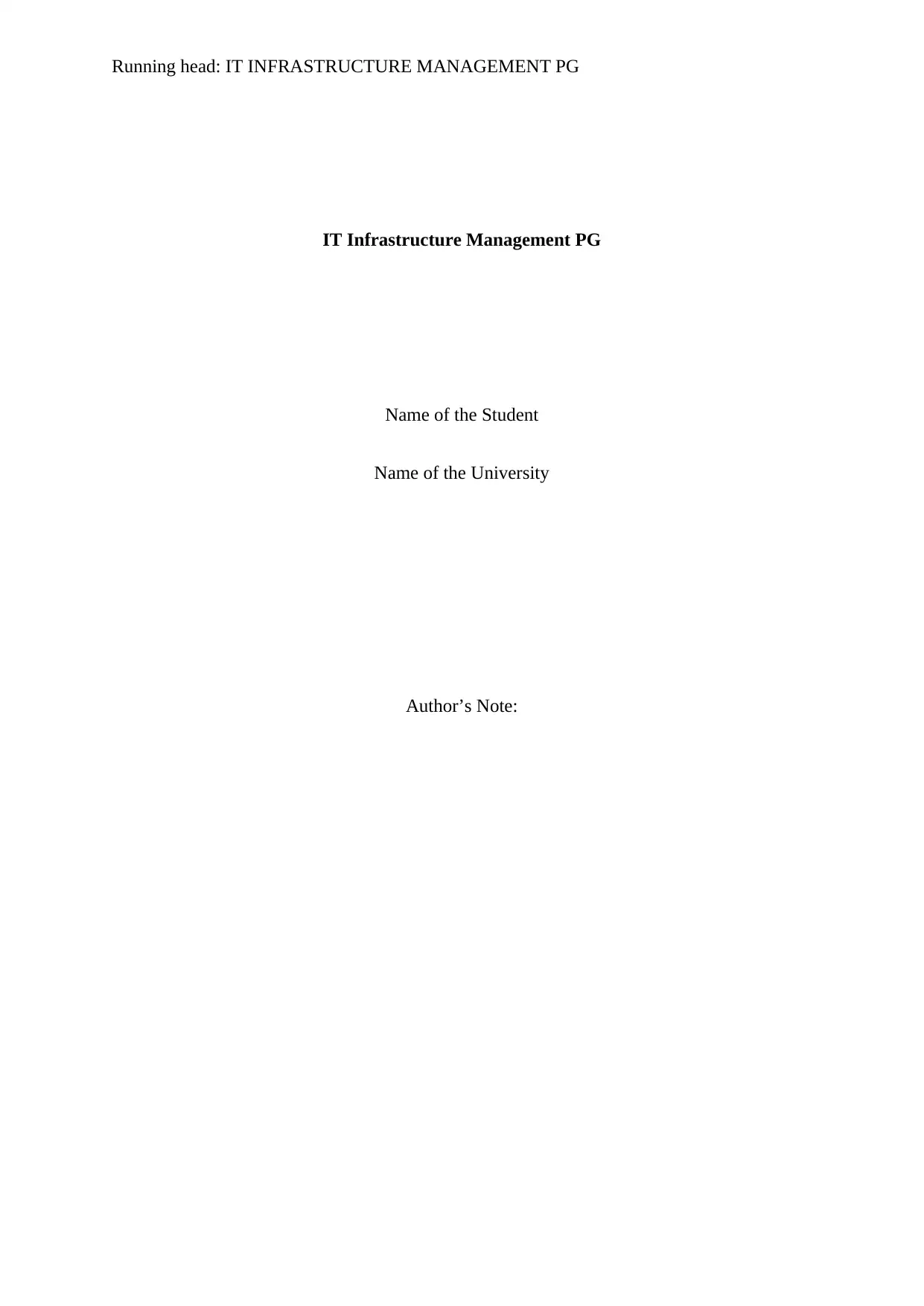
Running head: IT INFRASTRUCTURE MANAGEMENT PG
IT Infrastructure Management PG
Name of the Student
Name of the University
Author’s Note:
IT Infrastructure Management PG
Name of the Student
Name of the University
Author’s Note:
Paraphrase This Document
Need a fresh take? Get an instant paraphrase of this document with our AI Paraphraser
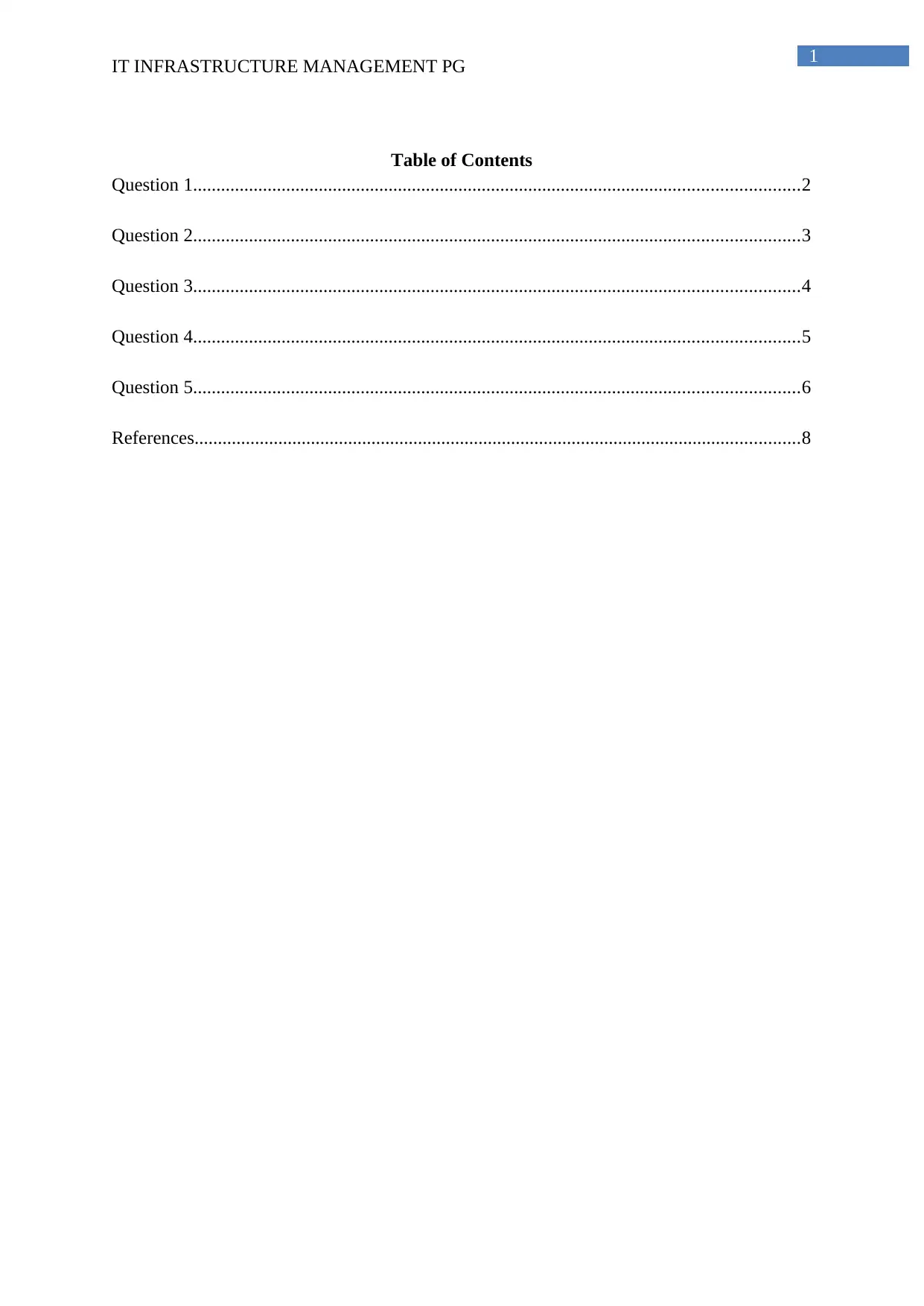
1
IT INFRASTRUCTURE MANAGEMENT PG
Table of Contents
Question 1..................................................................................................................................2
Question 2..................................................................................................................................3
Question 3..................................................................................................................................4
Question 4..................................................................................................................................5
Question 5..................................................................................................................................6
References..................................................................................................................................8
IT INFRASTRUCTURE MANAGEMENT PG
Table of Contents
Question 1..................................................................................................................................2
Question 2..................................................................................................................................3
Question 3..................................................................................................................................4
Question 4..................................................................................................................................5
Question 5..................................................................................................................................6
References..................................................................................................................................8
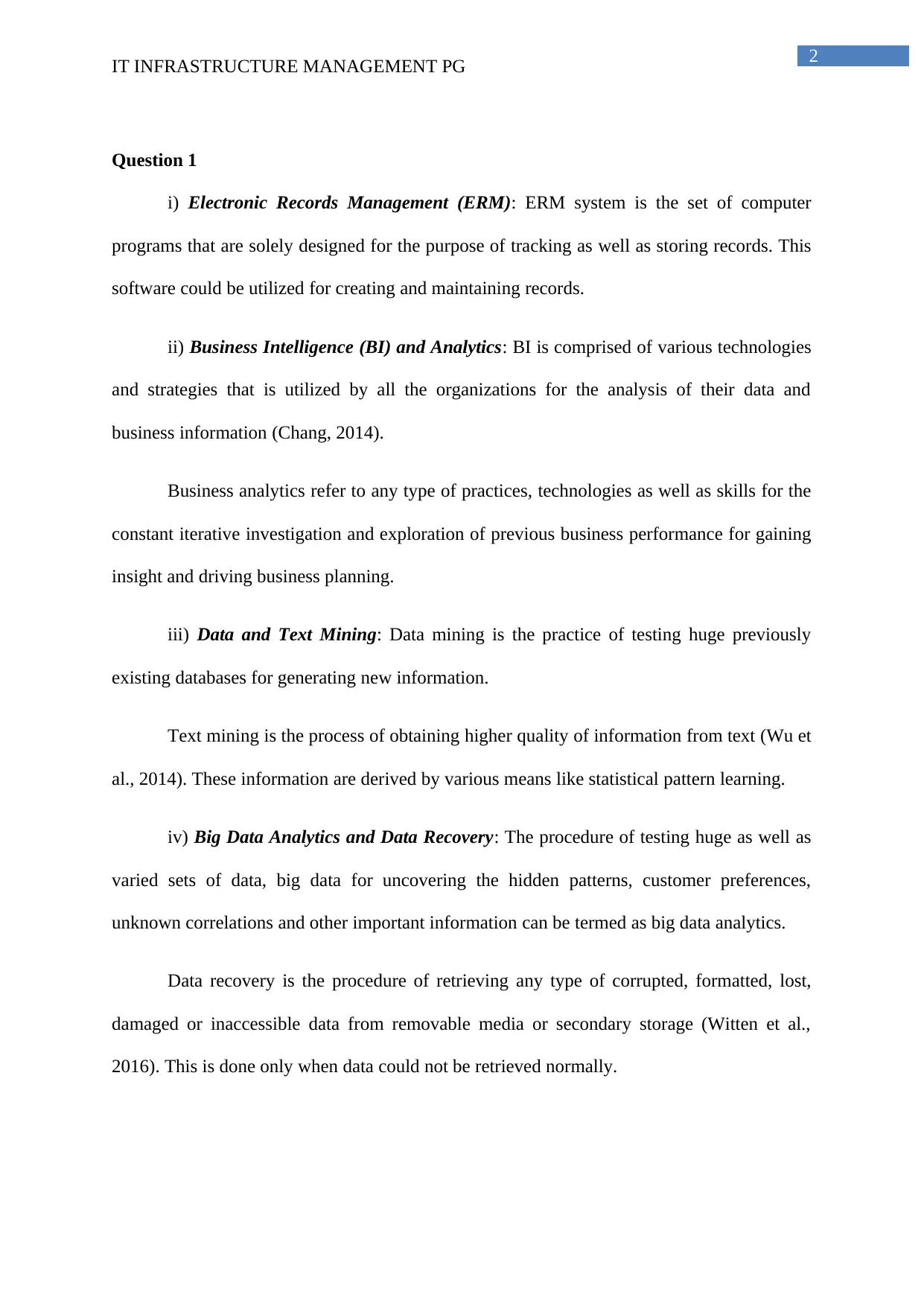
2
IT INFRASTRUCTURE MANAGEMENT PG
Question 1
i) Electronic Records Management (ERM): ERM system is the set of computer
programs that are solely designed for the purpose of tracking as well as storing records. This
software could be utilized for creating and maintaining records.
ii) Business Intelligence (BI) and Analytics: BI is comprised of various technologies
and strategies that is utilized by all the organizations for the analysis of their data and
business information (Chang, 2014).
Business analytics refer to any type of practices, technologies as well as skills for the
constant iterative investigation and exploration of previous business performance for gaining
insight and driving business planning.
iii) Data and Text Mining: Data mining is the practice of testing huge previously
existing databases for generating new information.
Text mining is the process of obtaining higher quality of information from text (Wu et
al., 2014). These information are derived by various means like statistical pattern learning.
iv) Big Data Analytics and Data Recovery: The procedure of testing huge as well as
varied sets of data, big data for uncovering the hidden patterns, customer preferences,
unknown correlations and other important information can be termed as big data analytics.
Data recovery is the procedure of retrieving any type of corrupted, formatted, lost,
damaged or inaccessible data from removable media or secondary storage (Witten et al.,
2016). This is done only when data could not be retrieved normally.
IT INFRASTRUCTURE MANAGEMENT PG
Question 1
i) Electronic Records Management (ERM): ERM system is the set of computer
programs that are solely designed for the purpose of tracking as well as storing records. This
software could be utilized for creating and maintaining records.
ii) Business Intelligence (BI) and Analytics: BI is comprised of various technologies
and strategies that is utilized by all the organizations for the analysis of their data and
business information (Chang, 2014).
Business analytics refer to any type of practices, technologies as well as skills for the
constant iterative investigation and exploration of previous business performance for gaining
insight and driving business planning.
iii) Data and Text Mining: Data mining is the practice of testing huge previously
existing databases for generating new information.
Text mining is the process of obtaining higher quality of information from text (Wu et
al., 2014). These information are derived by various means like statistical pattern learning.
iv) Big Data Analytics and Data Recovery: The procedure of testing huge as well as
varied sets of data, big data for uncovering the hidden patterns, customer preferences,
unknown correlations and other important information can be termed as big data analytics.
Data recovery is the procedure of retrieving any type of corrupted, formatted, lost,
damaged or inaccessible data from removable media or secondary storage (Witten et al.,
2016). This is done only when data could not be retrieved normally.
⊘ This is a preview!⊘
Do you want full access?
Subscribe today to unlock all pages.

Trusted by 1+ million students worldwide
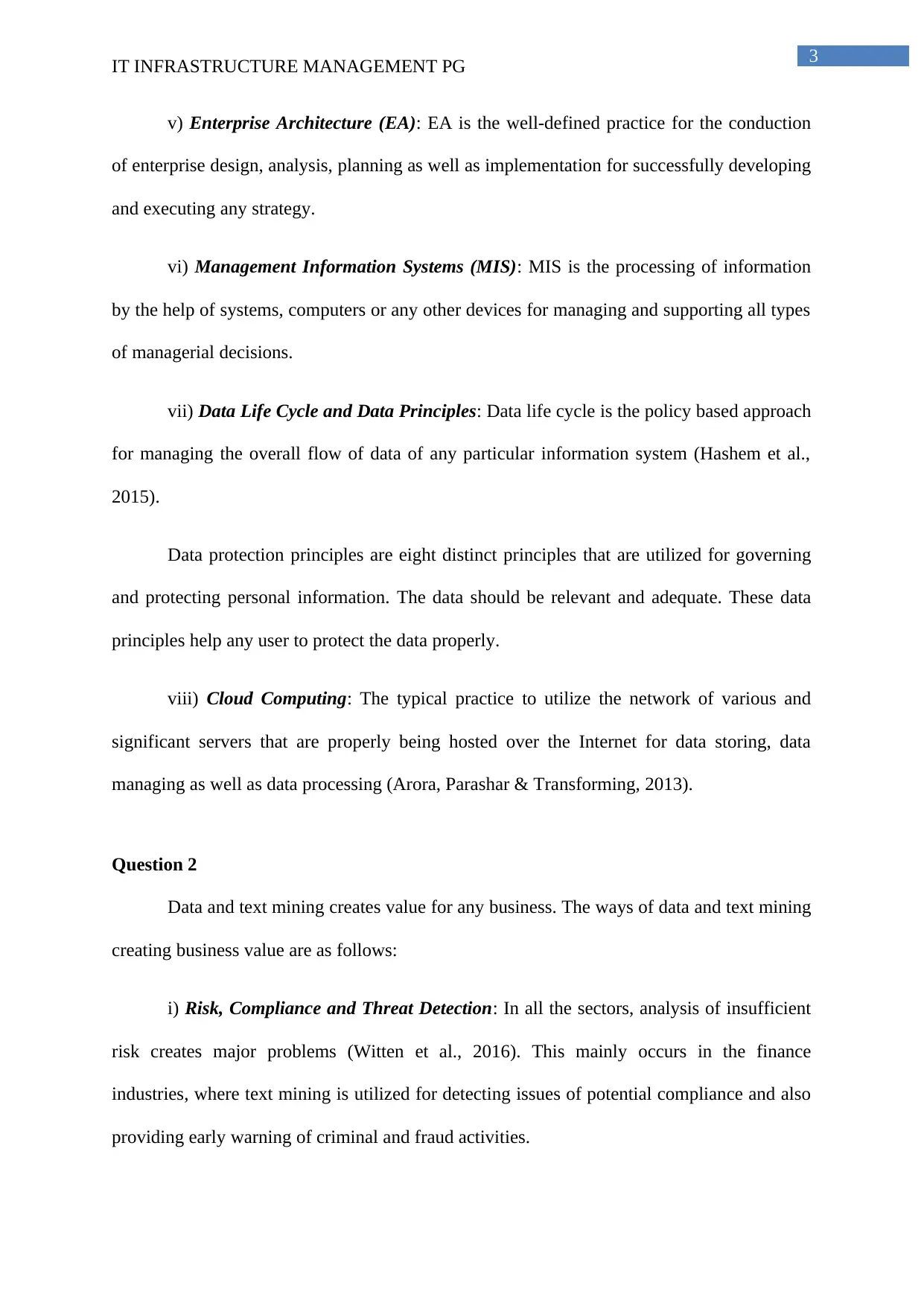
3
IT INFRASTRUCTURE MANAGEMENT PG
v) Enterprise Architecture (EA): EA is the well-defined practice for the conduction
of enterprise design, analysis, planning as well as implementation for successfully developing
and executing any strategy.
vi) Management Information Systems (MIS): MIS is the processing of information
by the help of systems, computers or any other devices for managing and supporting all types
of managerial decisions.
vii) Data Life Cycle and Data Principles: Data life cycle is the policy based approach
for managing the overall flow of data of any particular information system (Hashem et al.,
2015).
Data protection principles are eight distinct principles that are utilized for governing
and protecting personal information. The data should be relevant and adequate. These data
principles help any user to protect the data properly.
viii) Cloud Computing: The typical practice to utilize the network of various and
significant servers that are properly being hosted over the Internet for data storing, data
managing as well as data processing (Arora, Parashar & Transforming, 2013).
Question 2
Data and text mining creates value for any business. The ways of data and text mining
creating business value are as follows:
i) Risk, Compliance and Threat Detection: In all the sectors, analysis of insufficient
risk creates major problems (Witten et al., 2016). This mainly occurs in the finance
industries, where text mining is utilized for detecting issues of potential compliance and also
providing early warning of criminal and fraud activities.
IT INFRASTRUCTURE MANAGEMENT PG
v) Enterprise Architecture (EA): EA is the well-defined practice for the conduction
of enterprise design, analysis, planning as well as implementation for successfully developing
and executing any strategy.
vi) Management Information Systems (MIS): MIS is the processing of information
by the help of systems, computers or any other devices for managing and supporting all types
of managerial decisions.
vii) Data Life Cycle and Data Principles: Data life cycle is the policy based approach
for managing the overall flow of data of any particular information system (Hashem et al.,
2015).
Data protection principles are eight distinct principles that are utilized for governing
and protecting personal information. The data should be relevant and adequate. These data
principles help any user to protect the data properly.
viii) Cloud Computing: The typical practice to utilize the network of various and
significant servers that are properly being hosted over the Internet for data storing, data
managing as well as data processing (Arora, Parashar & Transforming, 2013).
Question 2
Data and text mining creates value for any business. The ways of data and text mining
creating business value are as follows:
i) Risk, Compliance and Threat Detection: In all the sectors, analysis of insufficient
risk creates major problems (Witten et al., 2016). This mainly occurs in the finance
industries, where text mining is utilized for detecting issues of potential compliance and also
providing early warning of criminal and fraud activities.
Paraphrase This Document
Need a fresh take? Get an instant paraphrase of this document with our AI Paraphraser
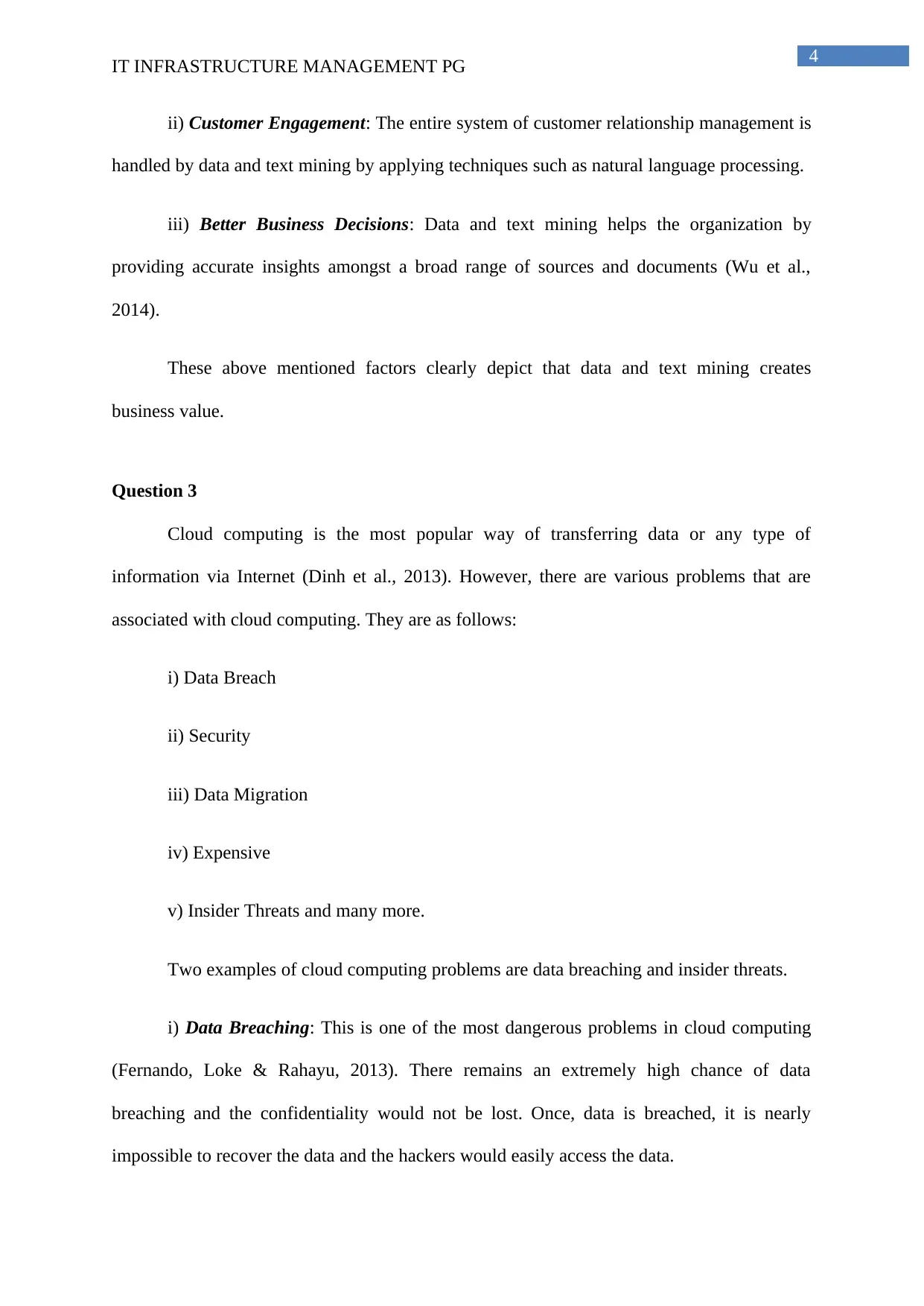
4
IT INFRASTRUCTURE MANAGEMENT PG
ii) Customer Engagement: The entire system of customer relationship management is
handled by data and text mining by applying techniques such as natural language processing.
iii) Better Business Decisions: Data and text mining helps the organization by
providing accurate insights amongst a broad range of sources and documents (Wu et al.,
2014).
These above mentioned factors clearly depict that data and text mining creates
business value.
Question 3
Cloud computing is the most popular way of transferring data or any type of
information via Internet (Dinh et al., 2013). However, there are various problems that are
associated with cloud computing. They are as follows:
i) Data Breach
ii) Security
iii) Data Migration
iv) Expensive
v) Insider Threats and many more.
Two examples of cloud computing problems are data breaching and insider threats.
i) Data Breaching: This is one of the most dangerous problems in cloud computing
(Fernando, Loke & Rahayu, 2013). There remains an extremely high chance of data
breaching and the confidentiality would not be lost. Once, data is breached, it is nearly
impossible to recover the data and the hackers would easily access the data.
IT INFRASTRUCTURE MANAGEMENT PG
ii) Customer Engagement: The entire system of customer relationship management is
handled by data and text mining by applying techniques such as natural language processing.
iii) Better Business Decisions: Data and text mining helps the organization by
providing accurate insights amongst a broad range of sources and documents (Wu et al.,
2014).
These above mentioned factors clearly depict that data and text mining creates
business value.
Question 3
Cloud computing is the most popular way of transferring data or any type of
information via Internet (Dinh et al., 2013). However, there are various problems that are
associated with cloud computing. They are as follows:
i) Data Breach
ii) Security
iii) Data Migration
iv) Expensive
v) Insider Threats and many more.
Two examples of cloud computing problems are data breaching and insider threats.
i) Data Breaching: This is one of the most dangerous problems in cloud computing
(Fernando, Loke & Rahayu, 2013). There remains an extremely high chance of data
breaching and the confidentiality would not be lost. Once, data is breached, it is nearly
impossible to recover the data and the hackers would easily access the data.
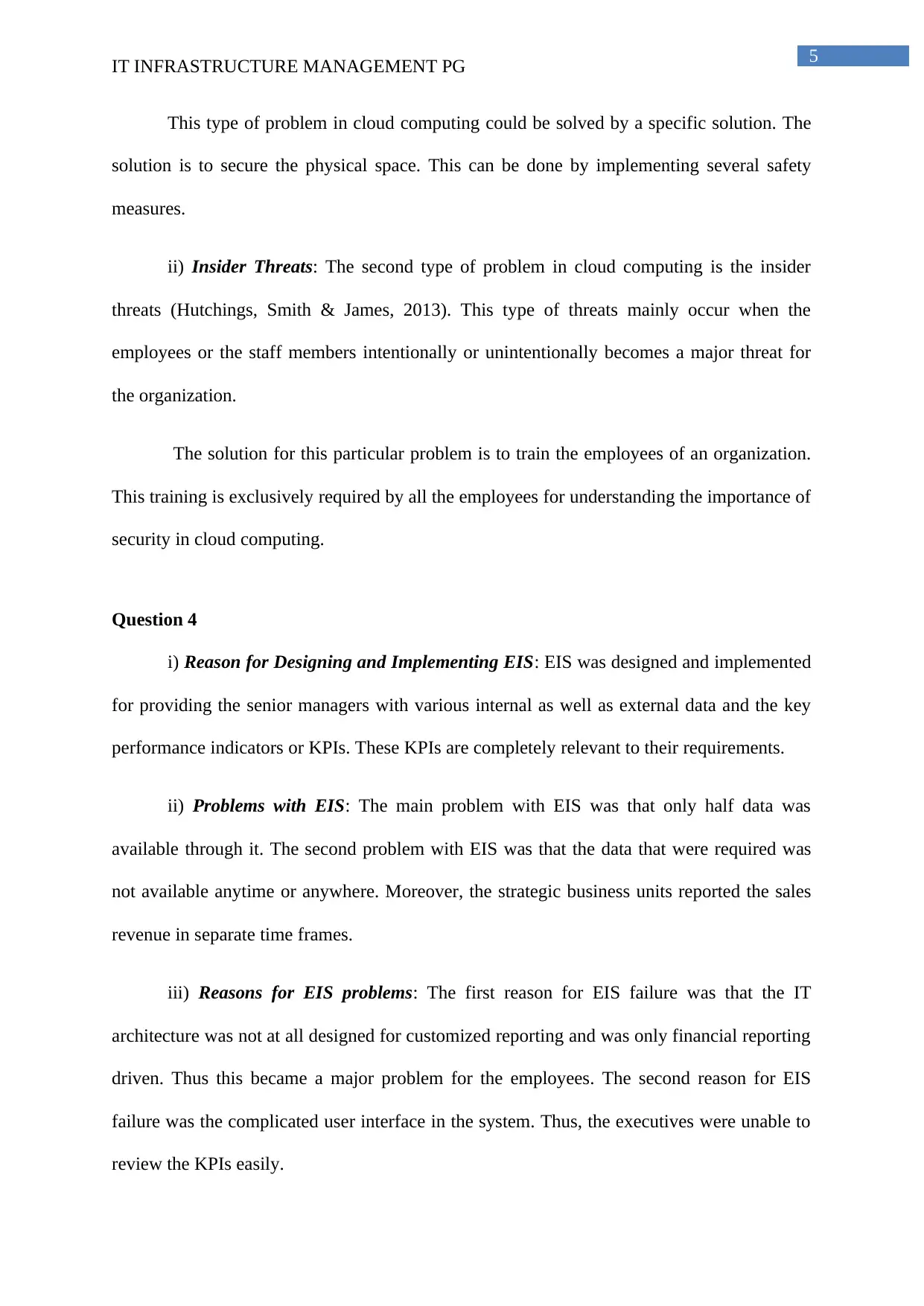
5
IT INFRASTRUCTURE MANAGEMENT PG
This type of problem in cloud computing could be solved by a specific solution. The
solution is to secure the physical space. This can be done by implementing several safety
measures.
ii) Insider Threats: The second type of problem in cloud computing is the insider
threats (Hutchings, Smith & James, 2013). This type of threats mainly occur when the
employees or the staff members intentionally or unintentionally becomes a major threat for
the organization.
The solution for this particular problem is to train the employees of an organization.
This training is exclusively required by all the employees for understanding the importance of
security in cloud computing.
Question 4
i) Reason for Designing and Implementing EIS: EIS was designed and implemented
for providing the senior managers with various internal as well as external data and the key
performance indicators or KPIs. These KPIs are completely relevant to their requirements.
ii) Problems with EIS: The main problem with EIS was that only half data was
available through it. The second problem with EIS was that the data that were required was
not available anytime or anywhere. Moreover, the strategic business units reported the sales
revenue in separate time frames.
iii) Reasons for EIS problems: The first reason for EIS failure was that the IT
architecture was not at all designed for customized reporting and was only financial reporting
driven. Thus this became a major problem for the employees. The second reason for EIS
failure was the complicated user interface in the system. Thus, the executives were unable to
review the KPIs easily.
IT INFRASTRUCTURE MANAGEMENT PG
This type of problem in cloud computing could be solved by a specific solution. The
solution is to secure the physical space. This can be done by implementing several safety
measures.
ii) Insider Threats: The second type of problem in cloud computing is the insider
threats (Hutchings, Smith & James, 2013). This type of threats mainly occur when the
employees or the staff members intentionally or unintentionally becomes a major threat for
the organization.
The solution for this particular problem is to train the employees of an organization.
This training is exclusively required by all the employees for understanding the importance of
security in cloud computing.
Question 4
i) Reason for Designing and Implementing EIS: EIS was designed and implemented
for providing the senior managers with various internal as well as external data and the key
performance indicators or KPIs. These KPIs are completely relevant to their requirements.
ii) Problems with EIS: The main problem with EIS was that only half data was
available through it. The second problem with EIS was that the data that were required was
not available anytime or anywhere. Moreover, the strategic business units reported the sales
revenue in separate time frames.
iii) Reasons for EIS problems: The first reason for EIS failure was that the IT
architecture was not at all designed for customized reporting and was only financial reporting
driven. Thus this became a major problem for the employees. The second reason for EIS
failure was the complicated user interface in the system. Thus, the executives were unable to
review the KPIs easily.
⊘ This is a preview!⊘
Do you want full access?
Subscribe today to unlock all pages.

Trusted by 1+ million students worldwide
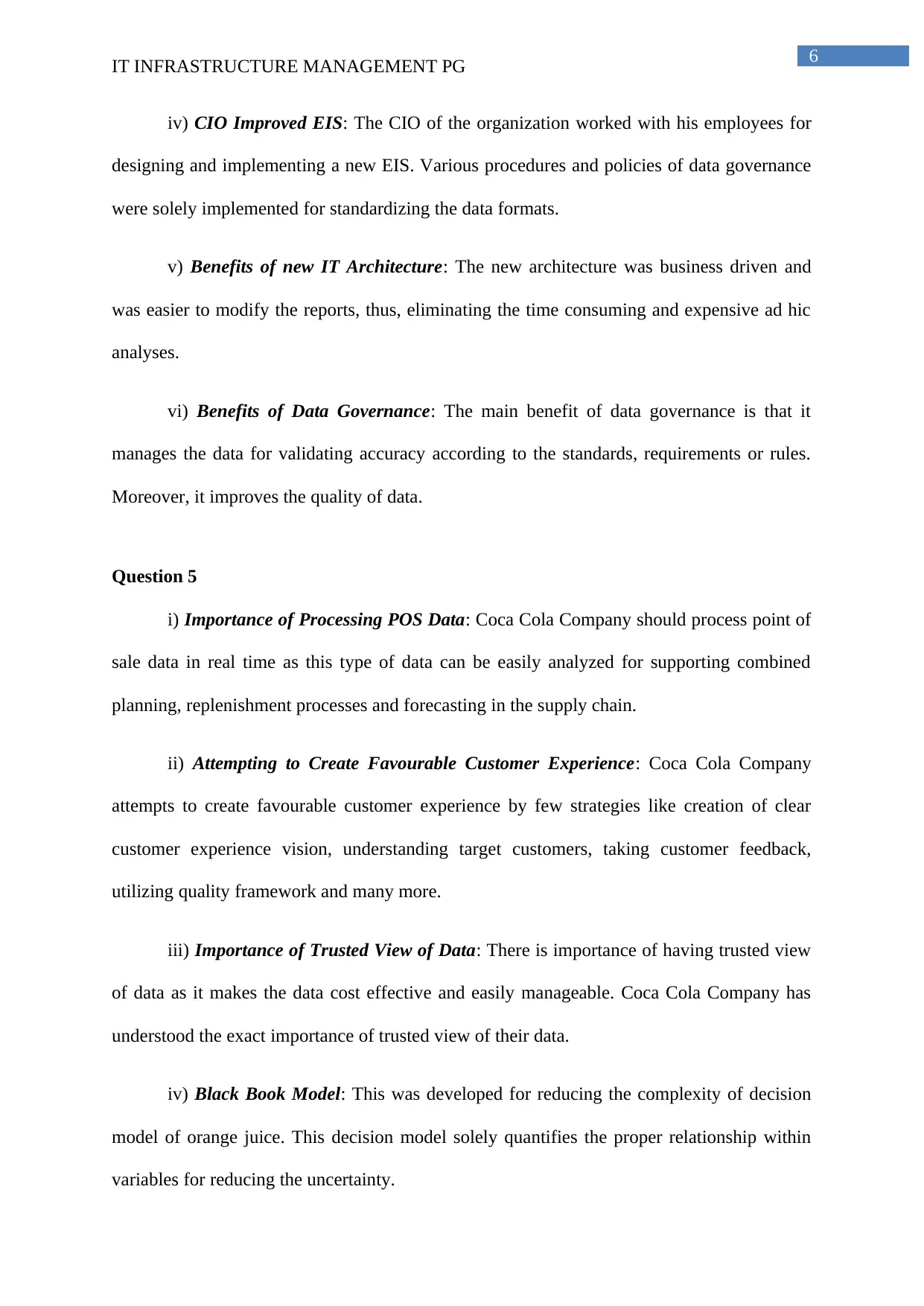
6
IT INFRASTRUCTURE MANAGEMENT PG
iv) CIO Improved EIS: The CIO of the organization worked with his employees for
designing and implementing a new EIS. Various procedures and policies of data governance
were solely implemented for standardizing the data formats.
v) Benefits of new IT Architecture: The new architecture was business driven and
was easier to modify the reports, thus, eliminating the time consuming and expensive ad hic
analyses.
vi) Benefits of Data Governance: The main benefit of data governance is that it
manages the data for validating accuracy according to the standards, requirements or rules.
Moreover, it improves the quality of data.
Question 5
i) Importance of Processing POS Data: Coca Cola Company should process point of
sale data in real time as this type of data can be easily analyzed for supporting combined
planning, replenishment processes and forecasting in the supply chain.
ii) Attempting to Create Favourable Customer Experience: Coca Cola Company
attempts to create favourable customer experience by few strategies like creation of clear
customer experience vision, understanding target customers, taking customer feedback,
utilizing quality framework and many more.
iii) Importance of Trusted View of Data: There is importance of having trusted view
of data as it makes the data cost effective and easily manageable. Coca Cola Company has
understood the exact importance of trusted view of their data.
iv) Black Book Model: This was developed for reducing the complexity of decision
model of orange juice. This decision model solely quantifies the proper relationship within
variables for reducing the uncertainty.
IT INFRASTRUCTURE MANAGEMENT PG
iv) CIO Improved EIS: The CIO of the organization worked with his employees for
designing and implementing a new EIS. Various procedures and policies of data governance
were solely implemented for standardizing the data formats.
v) Benefits of new IT Architecture: The new architecture was business driven and
was easier to modify the reports, thus, eliminating the time consuming and expensive ad hic
analyses.
vi) Benefits of Data Governance: The main benefit of data governance is that it
manages the data for validating accuracy according to the standards, requirements or rules.
Moreover, it improves the quality of data.
Question 5
i) Importance of Processing POS Data: Coca Cola Company should process point of
sale data in real time as this type of data can be easily analyzed for supporting combined
planning, replenishment processes and forecasting in the supply chain.
ii) Attempting to Create Favourable Customer Experience: Coca Cola Company
attempts to create favourable customer experience by few strategies like creation of clear
customer experience vision, understanding target customers, taking customer feedback,
utilizing quality framework and many more.
iii) Importance of Trusted View of Data: There is importance of having trusted view
of data as it makes the data cost effective and easily manageable. Coca Cola Company has
understood the exact importance of trusted view of their data.
iv) Black Book Model: This was developed for reducing the complexity of decision
model of orange juice. This decision model solely quantifies the proper relationship within
variables for reducing the uncertainty.
Paraphrase This Document
Need a fresh take? Get an instant paraphrase of this document with our AI Paraphraser

7
IT INFRASTRUCTURE MANAGEMENT PG
v) Strategic Benefit of Black Book Model: Black book model amalgamates the data
on more than six hundred flavours, which includes by making up of orange, cost pressures,
weather, expected crop yields, preferences of customer preferences, acidity rates, rates of
sweetness and even regional consumer preferences.
IT INFRASTRUCTURE MANAGEMENT PG
v) Strategic Benefit of Black Book Model: Black book model amalgamates the data
on more than six hundred flavours, which includes by making up of orange, cost pressures,
weather, expected crop yields, preferences of customer preferences, acidity rates, rates of
sweetness and even regional consumer preferences.
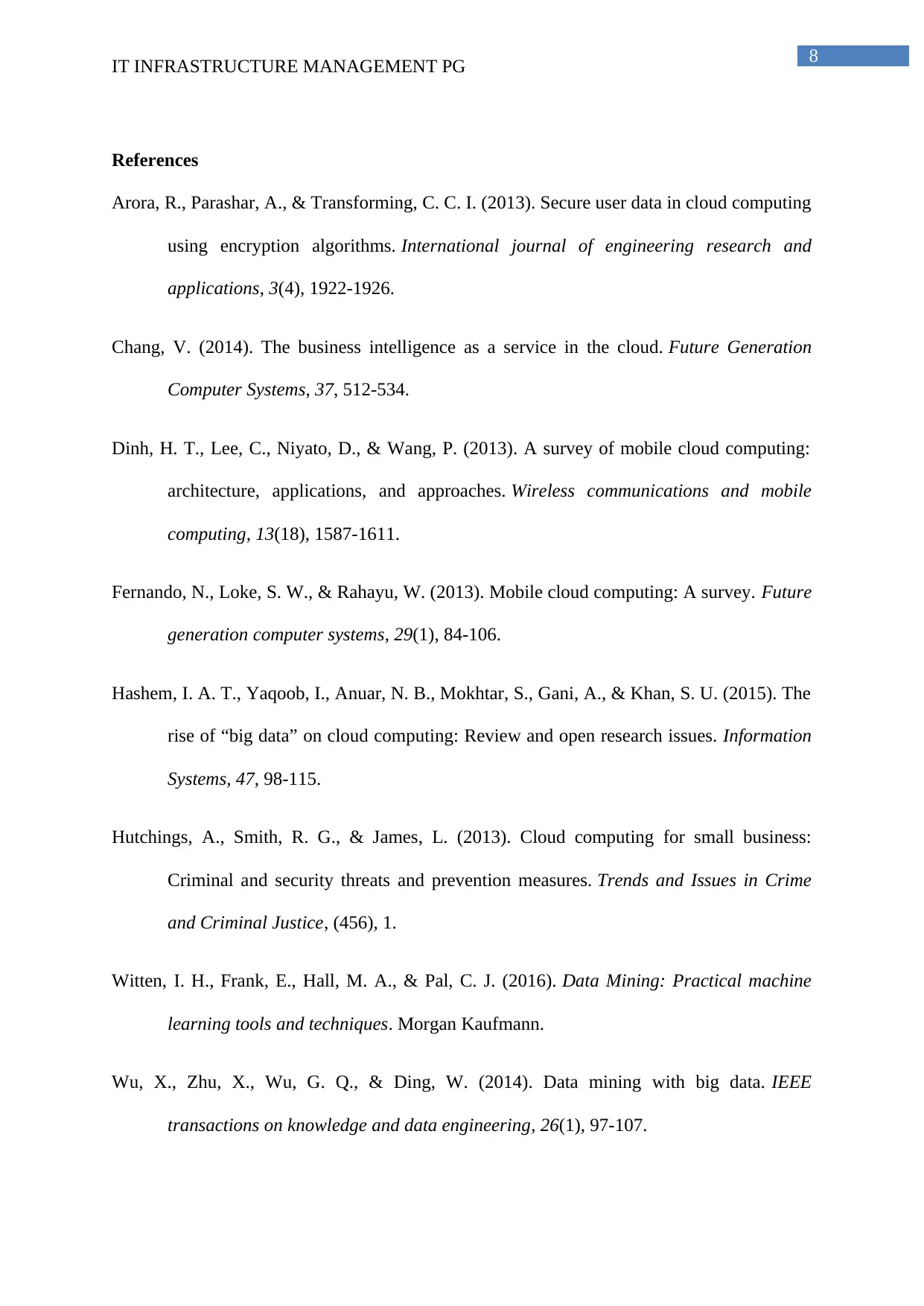
8
IT INFRASTRUCTURE MANAGEMENT PG
References
Arora, R., Parashar, A., & Transforming, C. C. I. (2013). Secure user data in cloud computing
using encryption algorithms. International journal of engineering research and
applications, 3(4), 1922-1926.
Chang, V. (2014). The business intelligence as a service in the cloud. Future Generation
Computer Systems, 37, 512-534.
Dinh, H. T., Lee, C., Niyato, D., & Wang, P. (2013). A survey of mobile cloud computing:
architecture, applications, and approaches. Wireless communications and mobile
computing, 13(18), 1587-1611.
Fernando, N., Loke, S. W., & Rahayu, W. (2013). Mobile cloud computing: A survey. Future
generation computer systems, 29(1), 84-106.
Hashem, I. A. T., Yaqoob, I., Anuar, N. B., Mokhtar, S., Gani, A., & Khan, S. U. (2015). The
rise of “big data” on cloud computing: Review and open research issues. Information
Systems, 47, 98-115.
Hutchings, A., Smith, R. G., & James, L. (2013). Cloud computing for small business:
Criminal and security threats and prevention measures. Trends and Issues in Crime
and Criminal Justice, (456), 1.
Witten, I. H., Frank, E., Hall, M. A., & Pal, C. J. (2016). Data Mining: Practical machine
learning tools and techniques. Morgan Kaufmann.
Wu, X., Zhu, X., Wu, G. Q., & Ding, W. (2014). Data mining with big data. IEEE
transactions on knowledge and data engineering, 26(1), 97-107.
IT INFRASTRUCTURE MANAGEMENT PG
References
Arora, R., Parashar, A., & Transforming, C. C. I. (2013). Secure user data in cloud computing
using encryption algorithms. International journal of engineering research and
applications, 3(4), 1922-1926.
Chang, V. (2014). The business intelligence as a service in the cloud. Future Generation
Computer Systems, 37, 512-534.
Dinh, H. T., Lee, C., Niyato, D., & Wang, P. (2013). A survey of mobile cloud computing:
architecture, applications, and approaches. Wireless communications and mobile
computing, 13(18), 1587-1611.
Fernando, N., Loke, S. W., & Rahayu, W. (2013). Mobile cloud computing: A survey. Future
generation computer systems, 29(1), 84-106.
Hashem, I. A. T., Yaqoob, I., Anuar, N. B., Mokhtar, S., Gani, A., & Khan, S. U. (2015). The
rise of “big data” on cloud computing: Review and open research issues. Information
Systems, 47, 98-115.
Hutchings, A., Smith, R. G., & James, L. (2013). Cloud computing for small business:
Criminal and security threats and prevention measures. Trends and Issues in Crime
and Criminal Justice, (456), 1.
Witten, I. H., Frank, E., Hall, M. A., & Pal, C. J. (2016). Data Mining: Practical machine
learning tools and techniques. Morgan Kaufmann.
Wu, X., Zhu, X., Wu, G. Q., & Ding, W. (2014). Data mining with big data. IEEE
transactions on knowledge and data engineering, 26(1), 97-107.
⊘ This is a preview!⊘
Do you want full access?
Subscribe today to unlock all pages.

Trusted by 1+ million students worldwide
1 out of 9
Related Documents
Your All-in-One AI-Powered Toolkit for Academic Success.
+13062052269
info@desklib.com
Available 24*7 on WhatsApp / Email
![[object Object]](/_next/static/media/star-bottom.7253800d.svg)
Unlock your academic potential
Copyright © 2020–2025 A2Z Services. All Rights Reserved. Developed and managed by ZUCOL.


